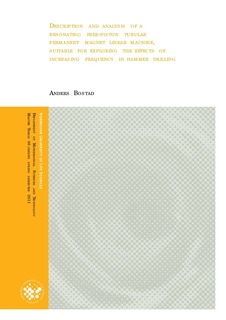Description and analysis of a resonating free-piston tubular permanent magnet linear machine, suitable for exploring the effects of increasing frequency in hammer drilling
Master thesis
Permanent lenke
http://hdl.handle.net/11250/188797Utgivelsesdato
2011-10-07Metadata
Vis full innførselSamlinger
- Master's theses (RealTek) [1722]
Sammendrag
A resonating tubular free-piston synchronous permanent magnet linear machine with gas springs, known as “prototype 2B”, has been designed in collaboration with Resonator AS. This combination of an electric linear machine and gas springs shows promising theoretical results for the intended application: A novel method of creating strong vibrations with high frequency. The intention of building prototype 2B is to contribute to the development of a hammer drill system, suitable for drilling in hard rock formations.
This thesis describes the main characteristics of the machine design, and discusses alternatives to the chosen topology. Performance parameters of 2B are analytically derived, and found suitable for exploring the effects of increasing hammer frequency in hard rock hammer drilling.
An important contribution of this thesis is a new theory, applicable for simple and effective analyses of the mechanical motion of two moving objects in 2B; piston and stator. The theory is defined for an ideal no-load situation with no external influence.
A moving mass equivalent, defined as a function of piston- and stator mass, is suggested and theoretically substantiated. Comparison to results from numerical simulations validates this model for the no-load ideal case.
This theory is applicable for directly relating acceleration, velocity and displacement of piston and stator, to the masses of the two objects. The moving mass equivalent is useful for easily calculating important performance properties, such as hammer amplitude, system energy and resonance frequency.
